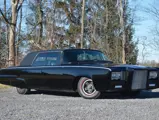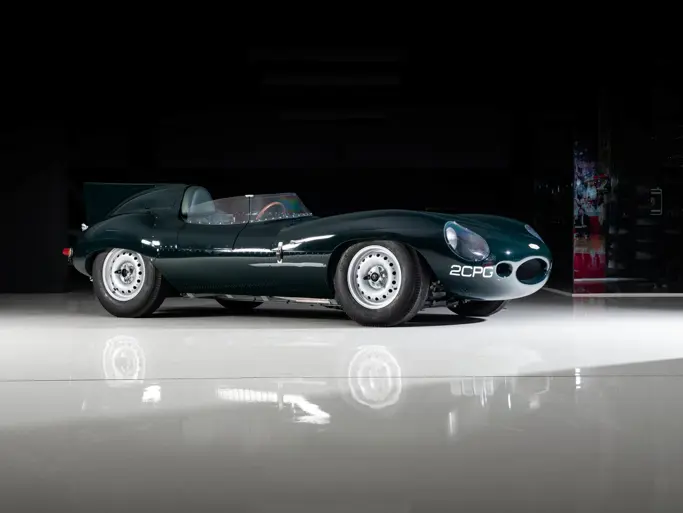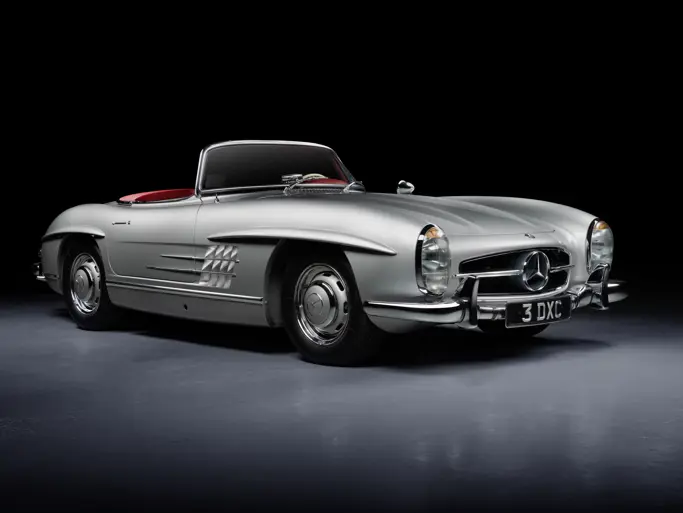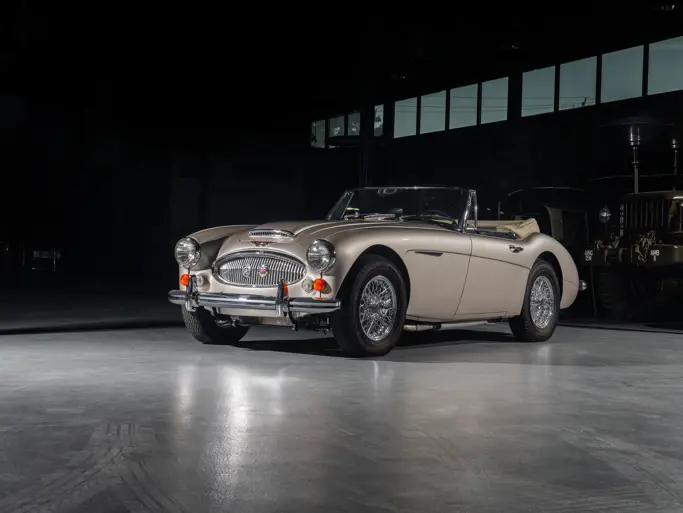Fort Lauderdale 2013
1965 Imperial ‘Black Beauty’
Dick Dean Built 'Green Hornet' Car
{{lr.item.text}}
$70,000 - $90,000 USD | Not Sold
 | Fort Lauderdale, Florida
| Fort Lauderdale, Florida
{{internetCurrentBid}}
{{internetTimeLeft}}

- Built by Dick Dean
- “Number one exhibition car”
- Ex-George Barris Collection
- Documented as such
- Quite accurate with magazine appearances
After seeing its pop-culture phenomenon ‘Batman’ become a huge television hit, Greenway Productions became a driving force of television programing in 1966. Produced in association with ABC-TV and 20th Century-Fox Studios, the show’s overwhelming success was due in part to the presence and gadgets of the Batmobile.
Executive head of Greenway Productions, William Dozier, was the brain behind the conceptual aspects of ‘Batman’; when attempting to duplicate that success, he and producers brought forth ‘The Green Hornet’ starring Van Williams as Britt Reid and Bruce Lee as Kato. The long-standing Green Hornet character originated as the star of a 1930s to 1950s radio series, and had previously been adapted to movie serials, comic books and other media. To follow the Batman prototype, this meant the need to create the rolling arsenal known as ‘The Black Beauty’ for The Green Hornet.
This task fell to Dean Jeffries, a Hollywood custom car builder, pin-stripe artist, painter, fabricator extraordinaire. Jeffries narrowly lost out to George Barris in building the Batmobile because of self-imposed time constraints. Dozier had been impressed by what he saw from Jeffries and again contacted him to craft this new gadget-filled auto. Greenway and Fox were looking for a vehicle to rival the Batmobile, but wanted something more refined in appearance. Jeffries chose a 1966 Imperial Crown for the undertaking. Long, dark and limousine-like was the image the producers and Jeffries were after. During the construction, Jeffries' ace fabricator / builder Dick Dean, set out to create a vehicle that was not only fully functional, but had a unique visual style – The Black Beauty has these qualities in abundance. The Black Beauty would soon become Chrysler’s first prominent Television / Movie car.
Jeffries and Dean created two cars (“Beauty 1” and “Beauty 2”) that were fully functional, as at this point in time, there were no digital special effects. The two original TV series cars are accounted for; one resides in a permanent Hollywood Gallery at the highly-respected Petersen Automotive Museum in Los Angeles. The other is restored and owned by a private party.
The Black Beauty that we have on offer is widely regarded as the “number one exhibition car.” This Black Beauty was also built by Dick Dean, utilizing his experience in building “Beauty 1” and “Beauty 2” to amazing results, as this Beauty is also out-fitted with the appropriate TV-car inspired mechanisms. This exacting work was performed at the Barris shop by Mr. Dean. Dick was the “real deal” in the heyday of Hollywood customs and the TV / Movie Industry. To those in the know; Mr. Jeffries, Mr. Barris and Dick Dean are all considered legendary custom car pioneers. When the time came to restore this Black Beauty to its current status, the work was again performed at the Barris location by Dick Dean and his son, Keith (Kid) Dean.
To further illustrate his influence in this business; Dick Dean met the now-legendary Barris in 1959 at the Detroit Autorama, while George was admiring his work, and offered Dick a job at Barris Kustom City if he should ever move to California from his Michigan home. By 1964, Dick Dean was running the Barris shops day-to-day operation and oversaw the building of TV cars for popular shows including, Batman (Batmobile), The Monkees (Monkeemobile), The Beverly Hillbillies (The Truck), The Munsters (The Munsters Koach and Dragula) and Mannix (numerous cars over the series’ eight year run). In addition to his collaboration with Dean Jeffries building “Beauty 1” and “Beauty 2”; Dick Dean and Dean Jeffries would go on to work together on numerous projects over the years that included (to name a few) movie character cars from Diamonds are Forever (James Bond), Jurassic Park, Ghostbusters, The Flintstones and Death Race 2000.
This Black Beauty was part of the George Barris Collection and sold with documentation (included in this sale), declaring it such, at the May 2005 Bonham & Butterfields car auction at the Petersen Automotive Museum. It carries the signatures of some of the principal people associated with the Black Beauty – Dean Jeffries, George Barris and Van Williams.
The car runs a Chrysler V-8 engine with automatic transmission and has the following changes and “options.” Only four purely cosmetic changes were made to the exterior of the car - the greenhouse sail panel was extended 14-inches to make the sedan look more like a limo, the door handles were eliminated and replaced with electric switches, the rear lights were redesigned to run up the trunk, and the gas tank filler flap was moved to a spot on the back deck ahead of the trunk, since the original spot in the center of the rear valance was taken by a gun.
In front, the grille is noted for a gun barrel that fictionally emits non-lethal Green Hornet gas. It's flanked by rocket launchers down below and, barely visible next to the launchers, there are retractable rams meant to hold the car upside down (and out of sight) on the underside of the rotating floor in The Green Hornet's garage. Up above, the headlights rotate from a regular pair to a green pair, which provides Kato his night-time 'infra-green' vision. Kato would use a green plastic panel that flipped down from the sun visor in conjunction with the lights. The sides are the clean, black lengths they appear to be, which only emphasizes the fact that the car is just under 19-feet in length. It's also low to the ground, further enhancing the sinister and stealthy look.
The devices are also abundant at the back of the car. There is a homing and tracking satellite / scanner that emerges from nicely fit doors in the trunk-lid, another gun barrel in the rear valance that fictionally emits grease, smoke and oil, and rotating rear license plates flanked by more rocket launchers. To cover its tracks – literally – The Black Beauty has brooms that descend from behind the rear wheels to disperse any unwanted trace evidence. For effects, there are compartments in the C-pillars that hide guns, and there are rectangular, hinged gun ports on both sides of the rear window so The Green Hornet could shoot unobstructed at those in pursuit.
To our understanding, this example was built as an exhibition car because of the cult-like status the show achieved through the presence of the late martial arts guru Bruce Lee and the worldwide interest he generated. Although it ran only one season for its production run, the series gave Lee his first Western media exposure and he soon found international stardom. By The Green Hornet being involved with co-promotion and sharing the screen on occasion with Batman, the attention to the two “superheroes” and their “supercars” was, and continues to demonstrate a high level of public interest – hence the need for such a car. This interest is further evidenced by the 2010 release of the Major Motion Picture, “The Green Hornet” by Sony / Columbia pictures and starring Seth Rogen and Steven Chow.
This Barris documented Black Beauty exhibition car has a great pedigree, runs smoothly and all of the gadget systems work flawlessly – it is presented in a manner that is “TV-car correct.” When you consider the design and builder lineage of this car, the interest it has received in magazine appearances (cover car for “Star Power” headline of seven page article titled "Lights, Camera, Action" in ‘Auto Enthusiast’ magazine – November 2011), and the attention to detail utilized in the building of this fun, iconic crime-fighting vehicle – you may want to don the green mask yourself. This documented Barris exhibition car gives you the true sense and sensation of TV crime-fighting of the 1960s at its finest.





